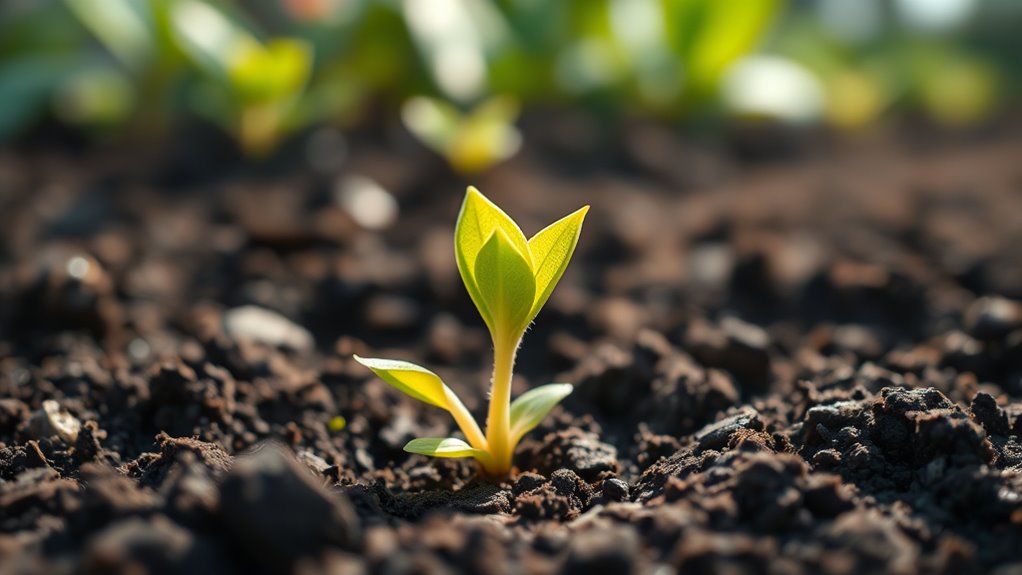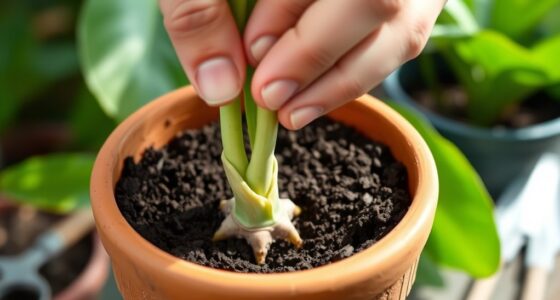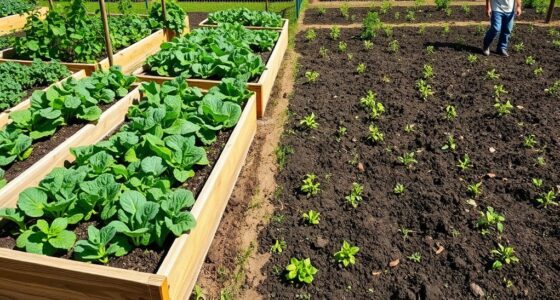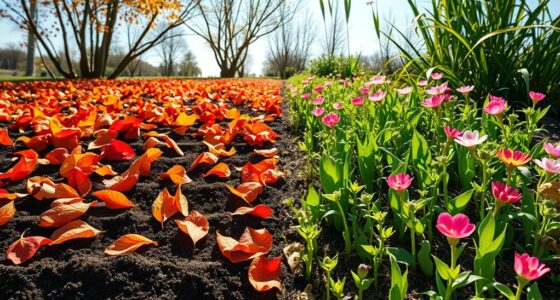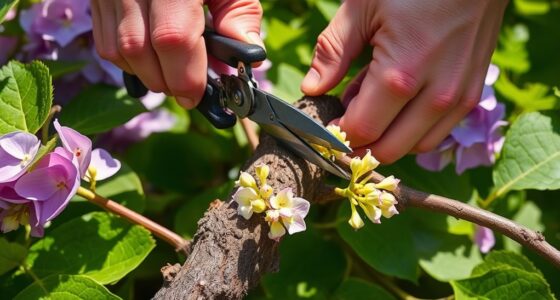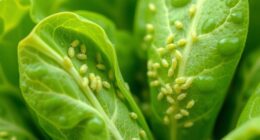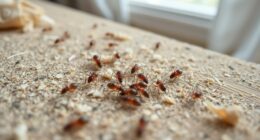To plant plumeria seeds, start by selecting healthy, mature seeds that sink when tested in water. Use well-draining soil and containers with drainage holes. Sow the seeds about half an inch deep and keep the soil consistently moist at 75-85°F. Cover lightly to maintain humidity and keep an eye on moisture levels. As they sprout, gradually shift seedlings to larger pots and provide bright, indirect sunlight. Continue exploring for detailed tips to guarantee your success.
Key Takeaways
- Soak seeds in warm water overnight to improve germination chances.
- Plant seeds 0.5 inches deep in well-draining soil with consistent moisture.
- Maintain temperature between 75-85°F and high humidity for optimal sprouting.
- Cover containers with plastic to retain humidity and check daily for sprouts.
- Transplant seedlings carefully into larger pots with good drainage once established.
Selecting and Preparing Plumeria Seeds
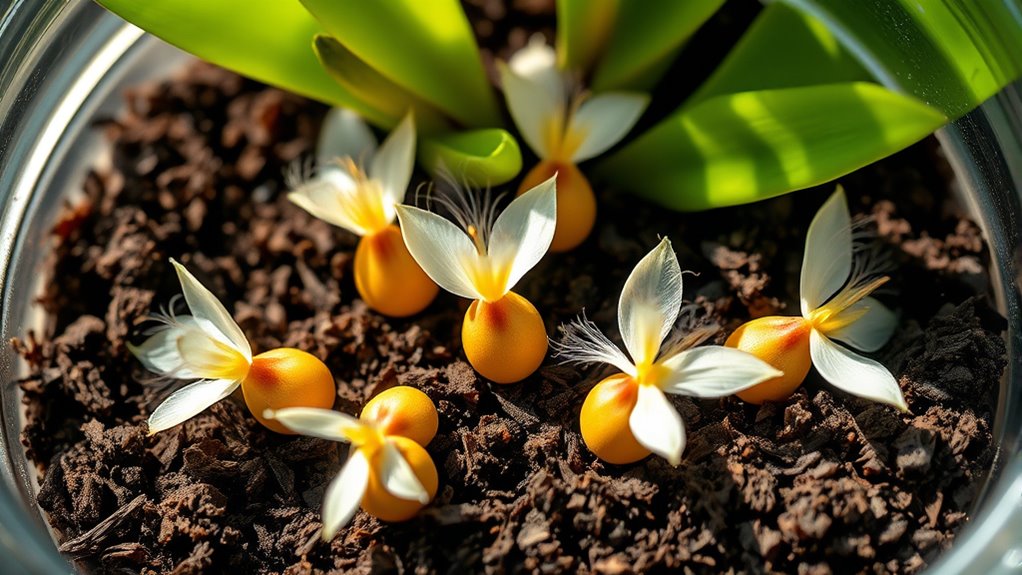
To successfully grow plumeria from seeds, you first need to select healthy, mature seeds that are plump and free from damage or mold. Plumeria seeds naturally have seed dormancy, which can delay germination. To overcome this, you might consider seed stratification—simulating winter conditions by chilling the seeds briefly. This process helps break dormancy and encourages sprouting. Look for seeds that are firm, with a smooth, shiny surface, and avoid any that are shriveled or discolored. Before planting, gently clean the seeds to remove any debris. Proper preparation guarantees better germination rates and healthy seedlings. Additionally, understanding the germination period of chia seeds can help you optimize planting times and care. Patience is key, as seed dormancy can extend the time it takes for your plumeria to sprout, especially when combined with seed dormancy mechanisms.
Choosing the Right Soil and Container
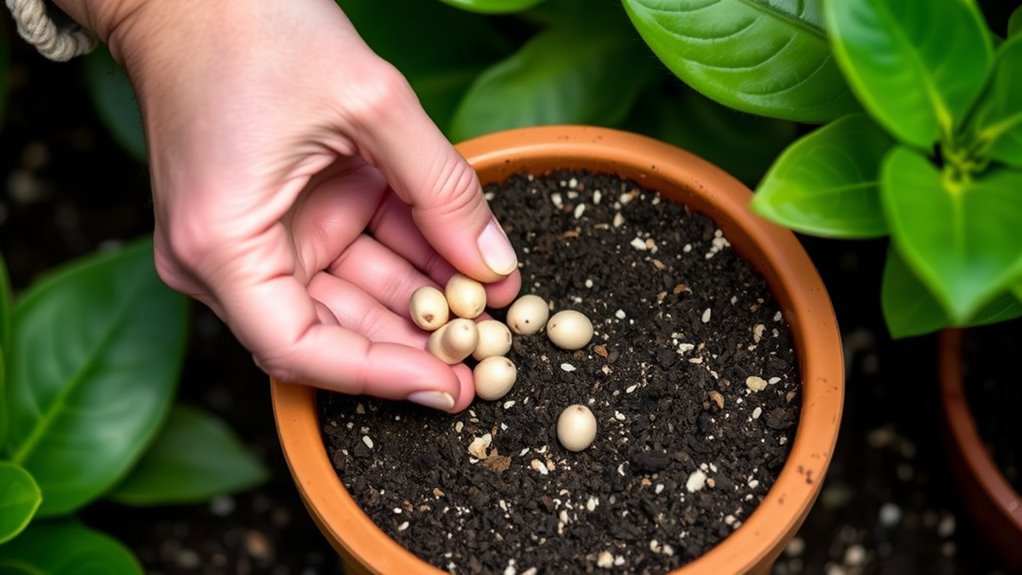
Choosing the right soil and container is key to healthy plumeria growth. You’ll want a container that provides good drainage and enough space for root development, while the soil should balance moisture retention with aeration. Pay attention to the pH level and nutrients to give your seeds the best start. Using self-watering plant pots can help maintain consistent moisture levels and reduce watering frequency, promoting healthier root systems. Selecting soil with proper drainage properties ensures that excess water doesn’t cause root rot, which is crucial for young seedlings.
Soil Drainage Needs
When selecting soil and containers for planting plumeria seeds, ensuring proper drainage is essential for healthy growth. Well-draining soil prevents waterlogging, which can cause root rot. You should focus on improving soil aeration by adding organic amendments like compost or peat moss. These amendments help create a light, loose structure that promotes root development while maintaining adequate moisture levels. Choosing a container with drainage holes is equally important to allow excess water to escape. Here’s a quick comparison:
| Soil Type | Drainage & Aeration Focus |
|---|---|
| Sandy Loam | Excellent drainage, good aeration |
| Organic Potting Mix | Light, retains moisture, with amendments |
| Clay-based Soil | Poor drainage, needs amendments |
| Pot with Drainage Holes | Prevents water accumulation |
Proper soil and container choices support healthy plumeria seed germination. Additionally, considering soil composition can make a significant difference in seed success. Selecting soils that balance moisture retention with good drainage helps ensure healthy root development and vigorous growth.
Container Size Selection
Selecting the right container size is key to ensuring healthy plumeria seed growth. A container that’s too small can restrict root development, leading to stunted growth and potentially harming seed viability. Conversely, an oversized container may retain excess moisture, risking root rot. Aim for a pot with drainage holes to prevent water accumulation. A container that allows enough space for roots to expand encourages strong root development, which supports overall plant health. When choosing, consider the seedling’s current size and future growth. Proper container size helps maintain ideal moisture levels and promotes steady growth. Remember, healthy roots are essential for seedling vitality, so selecting an appropriate pot size is a critical step in successful plumeria cultivation. Additionally, understanding the importance of growth environment in projectors can help you create optimal viewing conditions if you plan to enjoy your garden with outdoor entertainment. To further support healthy development, consider the soil composition and ensure it provides proper aeration and nutrients for young plants.
Ph and Nutrients
The right soil pH and nutrient balance are essential for healthy plumeria seed growth. Aim for a pH balance between 6.0 and 7.0, which helps your plant absorb nutrients effectively. If the soil is too acidic or alkaline, nutrient levels become imbalanced, leading to poor growth. Choose a well-draining soil mix rich in organic matter, such as compost or peat moss, to provide essential nutrients. Regularly check the soil’s pH and adjust if necessary, using pH testers or amendments. Avoid overly nutrient-dense soils, which can cause root rot or inhibit seedling development. Maintaining proper pH balance and nutrient levels gives your seedlings the most suitable environment needed for strong, healthy growth. Additionally, understanding resources and tools available, like soil testers, can help you better monitor and optimize soil conditions for optimal germination. Ensuring proper soil preparation is also crucial for preventing issues like poor germination or seedling stress. Proper soil conditions are vital for fostering healthy root development and overall seedling vitality.
Planting the Seeds Properly
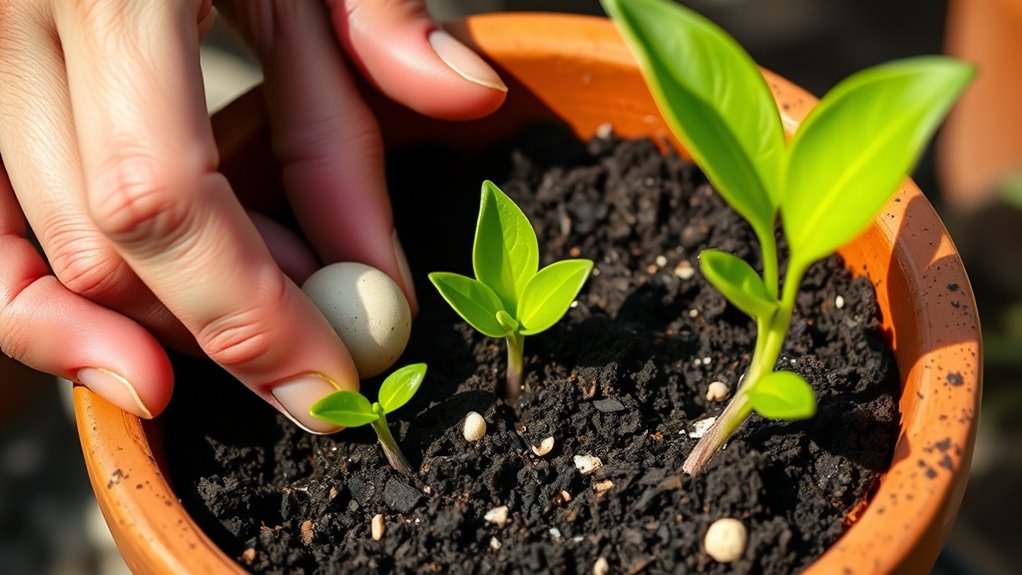
To guarantee successful germination, you need to plant plumeria seeds at the right depth and with proper spacing. Check seed viability before planting by performing a simple float test—viable seeds typically sink. When collecting seeds, ensure they are mature and free from damage or mold, as healthy seed collection boosts germination rates. Plant each seed about half an inch deep in well-draining soil, spacing them at least 2-3 inches apart to avoid overcrowding. Handle the seeds gently to prevent damage, and avoid planting them too deeply, which can hinder sprouting. Proper seed collection and planting techniques set the foundation for healthy seedlings and successful growth. Additionally, understanding the importance of seed viability can significantly improve your germination success. Ensuring proper soil conditions and maintaining consistent moisture levels are also crucial factors for optimal germination. Moreover, maintaining the right planting depth helps ensure the seeds sprout effectively and develop strong roots.
Providing Optimal Conditions for Germination
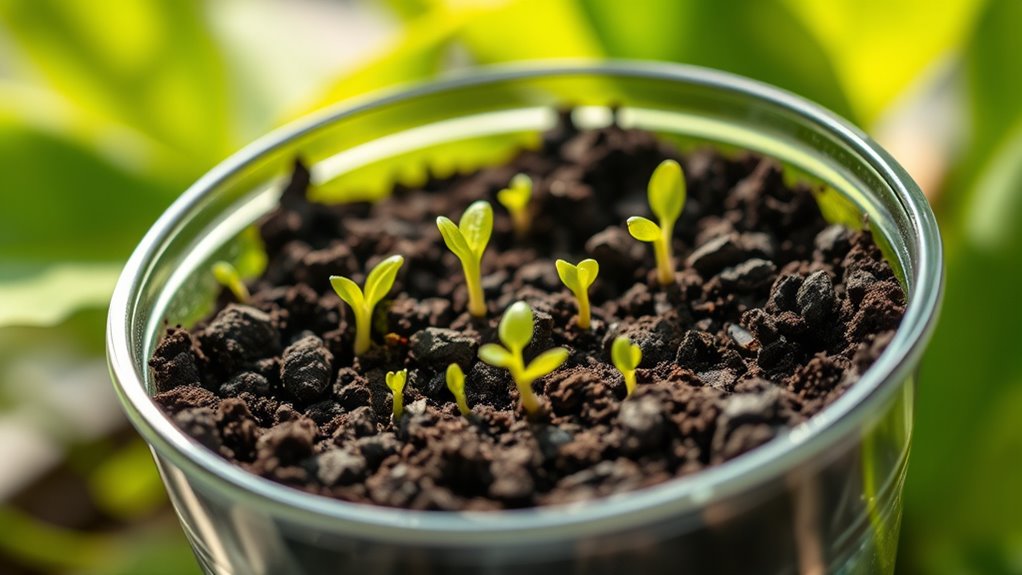
Providing the right environment is essential for successful plumeria seed germination. Before planting, guarantee your seeds are properly stored in a cool, dry place to maintain viability. If seeds have tough seed coats, consider seed scarification by gently nicking or sanding the surface to improve moisture absorption and encourage sprouting. Keep the planting medium warm and well-draining, ideally between 75-85°F, to promote healthy germination. Use a light layer of soil or seed-starting mix, avoiding overcrowding. Maintain consistent temperature and avoid drafts or sudden temperature changes, which can hinder germination. Proper seed storage and scarification help reveal the seed’s potential, creating ideal conditions for sprouting success. Additionally, understanding the best beaches can inspire a relaxing environment to cultivate your gardening passion outdoors. Creating the right soil conditions is also crucial for healthy seedling development. For optimal results, consider planting techniques that improve germination rates and seedling vigor. With these steps, you set a strong foundation for your plumeria seeds to grow.
Watering and Humidity Management
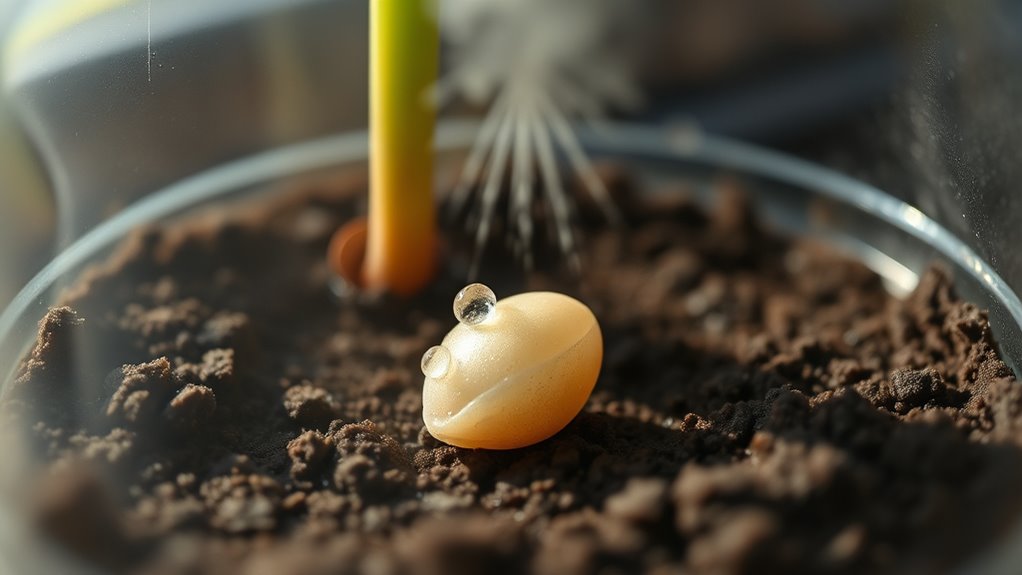
Once your plumeria seeds have been planted and the soil is prepared, managing watering and humidity becomes key to successful germination. You should establish a consistent watering schedule, keeping the soil moist but not waterlogged. Overwatering can lead to rot, so allow the top inch of soil to dry out slightly between waterings. Humidity control is equally important; maintaining high humidity around the seeds encourages healthy sprouting. You can achieve this by covering the container with a clear plastic lid or plastic wrap, ensuring good air circulation. Keep the environment warm and humid, but avoid excess moisture that can cause mold. Regularly check the moisture levels and adjust your watering schedule accordingly to promote ideal germination conditions. Additionally, using a vetted humidifier can help maintain consistent humidity levels, enhancing seedling growth. Monitoring environmental conditions closely ensures optimal germination success and healthy seedling development.
Monitoring Seeds During the Germination Process
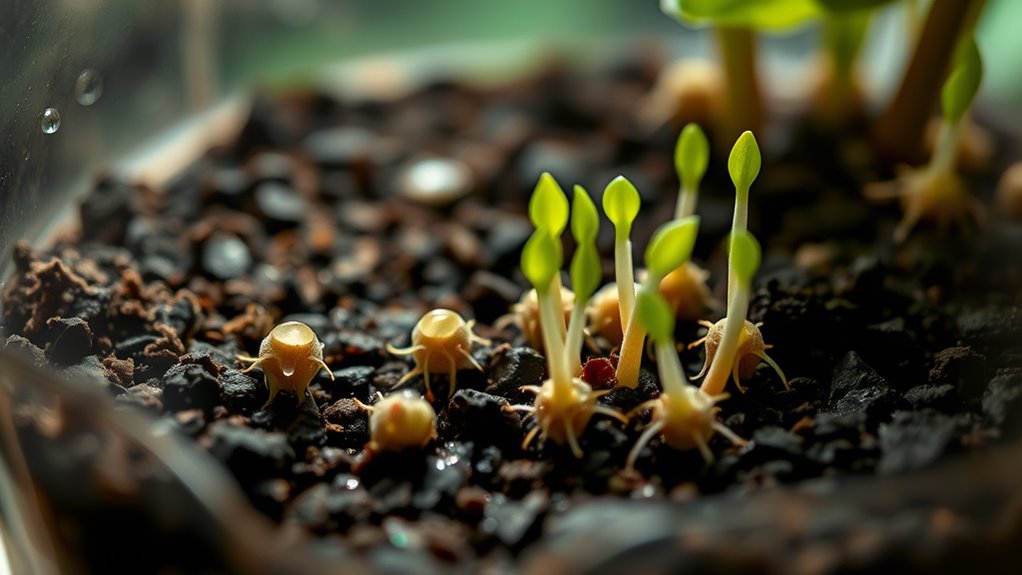
As your seeds begin to sprout, keep a close eye on them for any signs of mold growth, which can quickly damage your seedlings. Track their progress daily to see when tiny shoots emerge and grow stronger. Staying attentive now guarantees you catch problems early and support healthy germination.
Watch for Mold Growth
While monitoring your plumeria seeds during germination, it’s important to keep a close eye for mold growth. Mold prevention is essential to ensure healthy seed development. If you notice any fuzzy or discolored patches, take action immediately, as fungal growth can quickly spread and damage your seeds. To prevent mold, maintain proper airflow around your seed containers and avoid overwatering. Make sure the soil stays moist but not waterlogged, as excess moisture encourages fungal growth. Regularly check your seeds and remove any moldy spots or contaminated material. Keeping the environment clean and well-ventilated reduces the risk of mold formation. Vigilance during this stage helps ensure your seeds germinate successfully without the setbacks caused by mold or fungal growth.
Track Sprouting Progress
Keeping a close eye on your plumeria seeds during germination is essential to guarantee healthy sprouting. Monitoring their progress helps you assess seed viability and germination timing. To do this effectively, focus on these key steps:
- Check for sprouting signs daily, noting the emergence of tiny roots or shoots.
- Maintain consistent moisture and temperature, ensuring seeds don’t dry out or rot.
- Observe seed behavior; healthy seeds typically sprout within 1-3 weeks, depending on conditions.
Tracking these indicators helps you determine if your seeds are viable and germinating as expected. If no signs of sprouting appear after the expected germination timing, you may need to reassess seed quality or environmental factors. Accurate monitoring maximizes your success rate.
Transplanting Seedlings to Larger Pots

Once your plumeria seedlings have developed several true leaves and a strong root system, it’s time to transplant them into larger pots. Before transplanting, consider how seed storage and seed dormancy affected germination. Proper seed storage helps maintain seed viability, ensuring healthy seedlings, while understanding seed dormancy conditions can prevent premature sprouting or failure. Handle the seedlings gently, carefully loosening the soil around their roots to avoid damage. Choose a slightly larger pot with good drainage, and fill it with well-draining soil. Gently place the seedling into the new pot, ensuring the roots are spread out, then fill in around it. Water thoroughly to settle the soil and encourage root growth. Proper transplanting sets the stage for healthy plumeria development.
Caring for Young Plumeria Plants
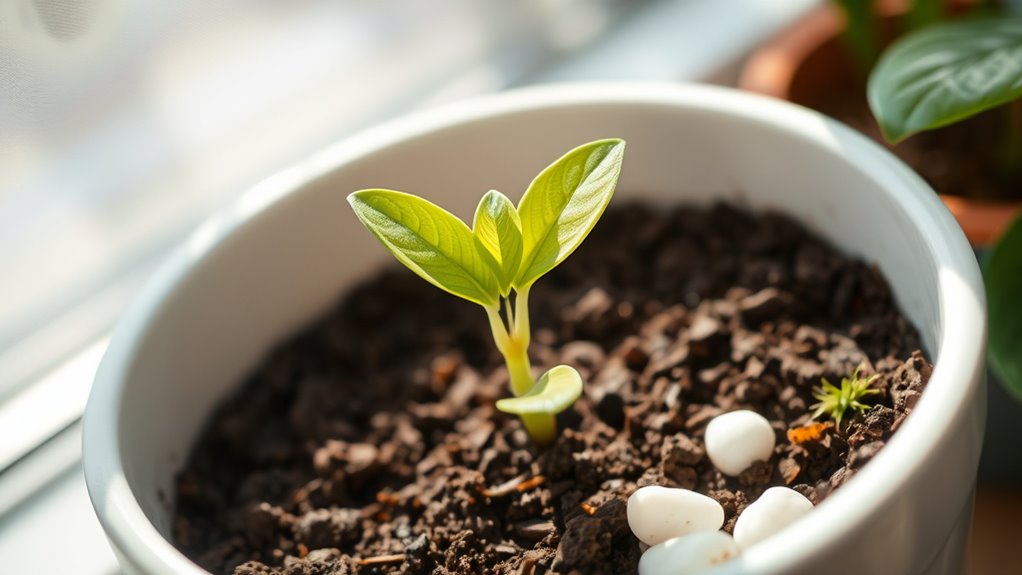
As your young plumeria plants grow, you’ll need to keep the soil consistently moist but not soggy. Watch out for pests like aphids and scale, and take action quickly if you spot any. Proper watering and pest protection will help guarantee healthy, vibrant plants.
Watering and Moisture Needs
Young plumeria plants require consistent moisture to establish healthy roots and promote vigorous growth. Proper moisture control is essential to prevent over- or underwatering. To achieve this, you should focus on effective watering techniques, such as:
- Water deeply when the top inch of soil feels dry.
- Use drainage pots to avoid waterlogged roots.
- Water early in the day to allow excess moisture to evaporate.
These steps help maintain ideal moisture levels, ensuring your young plumeria receives enough water without risking root rot. Adjust your watering schedule based on weather conditions and soil moisture. Regular monitoring allows you to fine-tune your watering techniques and keep your plant healthy. Proper moisture management is key to supporting strong root development and vibrant growth in your young plumeria.
Protecting From Pests
Protecting your young plumeria from pests is essential for healthy growth and vibrant blooms. Start by choosing pest-resistant varieties to reduce vulnerability. Regularly inspect leaves for signs of pests like aphids or scale. Use natural pest repellents such as neem oil or insecticidal soap to deter unwanted visitors. Keep your plant healthy with proper watering and fertilization, as strong plants resist pests better. Implement these strategies effectively with this quick reference:
| Pest Type | Natural Control Methods | Prevention Tips |
|---|---|---|
| Aphids | Neem oil, insecticidal soap | Regular inspections |
| Scale | Horticultural oil | Remove infested leaves |
| Spider mites | Neem oil, water sprays | Maintain humidity levels |
| Caterpillars | Handpicking, natural predators | Cover young plants |
| Fungal pests | Proper watering, airflow | Avoid overwatering |
Ensuring Proper Light and Temperature
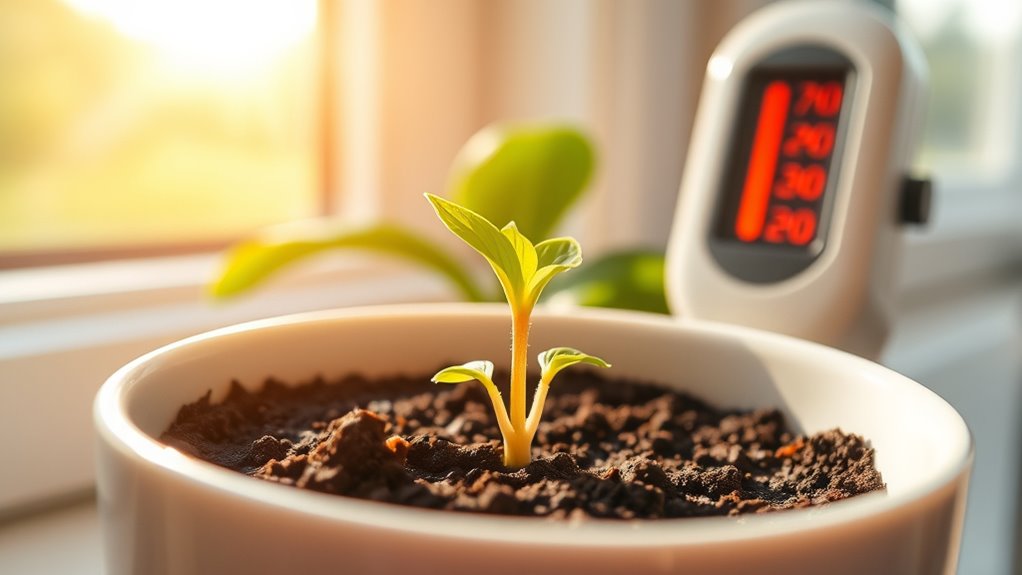
Ensuring your plumeria seeds receive the right amount of light and warmth is essential for healthy germination and growth. Proper sunlight exposure and temperature regulation create ideal conditions for sprouting. To achieve this:
- Place your seeds in a bright spot with indirect sunlight; direct sun can scorch tender seedlings.
- Maintain a consistent temperature between 70-85°F (21-29°C) to promote germination.
- Use a heat mat if your environment is cooler to help regulate temperature and boost sprouting success.
Monitor the environment regularly, ensuring the seeds aren’t exposed to drafts or sudden temperature drops. Adequate light and warmth accelerate germination, giving your plumeria the best start toward healthy, vibrant growth.
Troubleshooting Common Growth Challenges
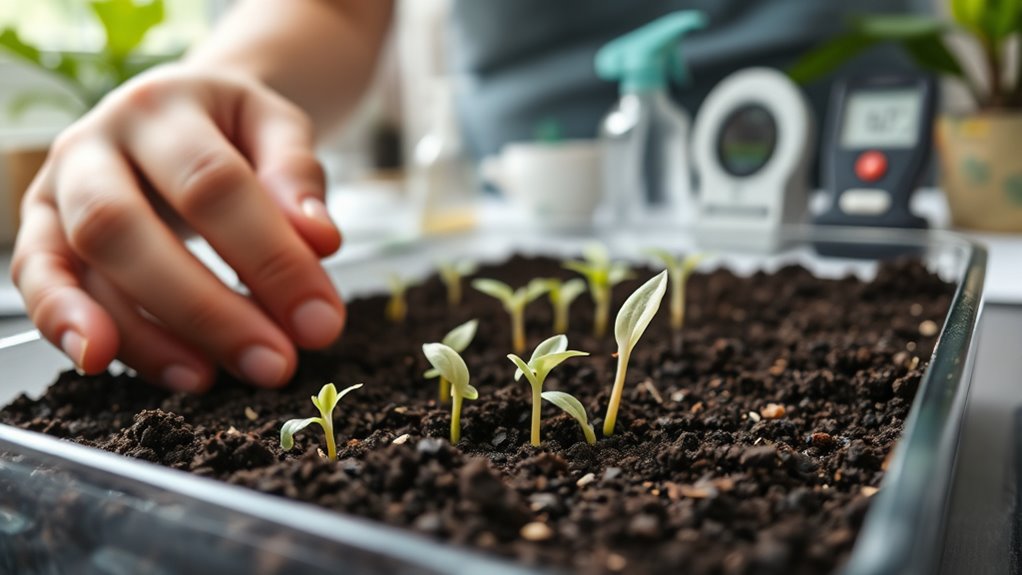
Even with proper care, plumeria seedlings can face growth challenges that hinder their development. Seed dormancy may delay germination or cause uneven growth, especially if conditions aren’t ideal. To overcome this, ensure you’re providing consistent warmth and moisture, as dormant seeds need patience and proper environment to sprout. Genetic variability can also lead to unpredictable growth patterns, with some seedlings struggling more than others. If you notice weak or stunted growth, check for issues like overwatering, poor soil drainage, or insufficient light. Adjust your care routine accordingly. Remember, each seed’s genetic makeup influences its resilience, so some plants may naturally grow slower or exhibit different traits. Troubleshooting these challenges involves patience, proper environmental control, and understanding that variability is normal.
Frequently Asked Questions
How Long Does It Typically Take for Plumeria Seeds to Germinate?
You’ll typically see plumeria seeds germinate within 7 to 14 days, but seed dormancy can affect this timeline. To encourage germination, keep the soil at a warm germination temperature of around 75-85°F. If the seeds don’t sprout immediately, maintain consistent warmth and moisture. Patience is key, as some seeds may take a little longer, but proper conditions will help you achieve successful germination.
Can Plumeria Seeds Be Germinated Indoors Year-Round?
You can absolutely germinate plumeria seeds indoors year-round, enjoying indoor germination regardless of seasons. With the right temperature, humidity, and light, you create an ideal environment for your seeds to sprout and grow. This approach allows you to bypass seasonal planting constraints, giving you the flexibility to nurture your plumeria whenever you wish. Keep consistent care and patience, and you’ll see your beautiful plants flourish indoors throughout the year.
What Are Common Pests That Affect Young Plumeria Plants?
You should watch for common pests like spider mites, aphids, and whiteflies that can harm your young plumeria plants. To prevent these issues, practice pest prevention by regularly inspecting your plants and keeping the area clean. Use organic treatments like neem oil or insecticidal soap to control pests without harming beneficial insects. Staying vigilant helps ensure healthy growth and lush blooms for your plumeria.
How Often Should I Fertilize My Growing Plumeria Seedlings?
Sure, you’d think plants are low-maintenance, right? But for your plumeria seedlings, a consistent fertilizer schedule is key. You should feed them every 2-3 weeks with a balanced, water-soluble fertilizer to meet their nutrient requirements. Over-fertilizing can burn roots, and under-fertilizing stalls growth. Keep it steady, and your seedlings will thrive, bursting into vibrant blooms before you know it!
What Are Signs of Overwatering or Underwatering in Plumeria Seedlings?
You should watch for watering stress signs like yellowing leaves, wilting, or stunted growth, which indicate overwatering or underwatering. Overwatering can cause root rot, making roots look brown and mushy, while underwatering leads to dry, brittle stems. To keep your plumeria seedlings healthy, maintain consistent moisture, avoid soggy soil, and check the soil regularly to prevent watering stress that hampers growth.
Conclusion
With patience and the right care, your plumeria seeds will thrive and reward you with beautiful blossoms. Don’t worry if germination takes time—consistent watering, proper light, and warm temperatures make all the difference. Even if you face setbacks, stay persistent, and you’ll soon enjoy the lush, fragrant plumeria trees you’ve nurtured from seed. Just remember, every expert was once a beginner, so keep cultivating your green thumb!
